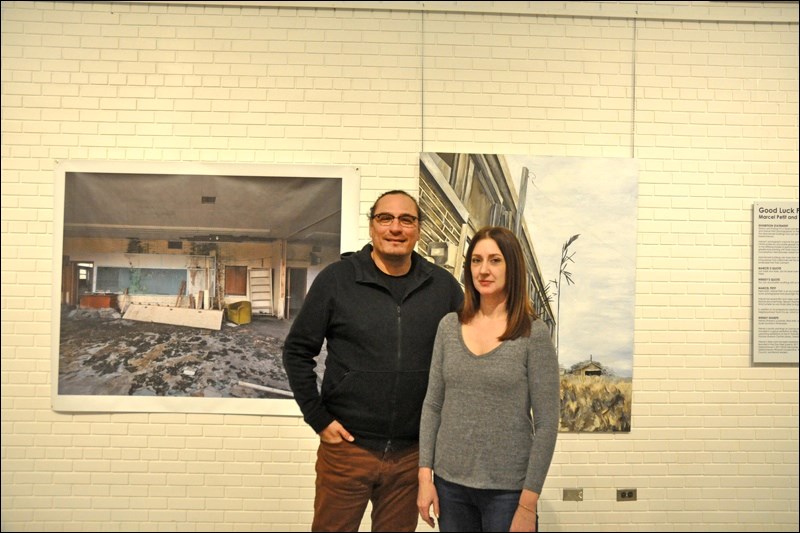The images of Marcel Petit and Wendy Sharpe’s new Chapel Gallery exhibit are all too familiar for rural Saskatchewanians, although they look for beauty in rural buildings locals might consider old junk.
Good Luck Finding Itis an exhibit featuring large photos of rural and small town things placed beside large paintings, of those same things. Subjects include unoccupied buildings in towns and on farms, and the province’s most famous and abundant renewable resource: prairie.
Petit said the buildings tell part of Saskatchewan’s story, as they are “all over the place.”
The pictures came from one long day of driving to places in southern Saskatchewan, including Girvin, Jonesville and Central Butte. The population of some of the towns they visited consisted of a few families.
Petit said when describing their project, some assumed Sharpe would be painting his photos, but that wasn’t the case. He took photos, and Sharpe took her own reference shots, which she then turned into paintings.
Some of the places Petit and Sharpe visited have small populations, but where they could, they set out to eat a piece of local apple pie.
“Of all these towns we only found one place that had good apple pie,” Petit said. “You’d think that every small town would have a place with apple pie, but they don’t.”
“Come on, Saskatchewan.”
One building was made of handmade bricks, “and it’s really astonishing what they did with it.”
A quick pass through such towns on internet maps reveals the settlements might not even be considered towns. The division between public and private property isn’t clear.
Petit said he and Sharpe weren’t bothered by anybody as they took their photos, although “it’s creepy being in these places because you wait for somebody to show up and go ‘what are you doing, get out of here.’”
In Central Butte, Petit said he thinks locals were talking about the two strangers.
While on Main Street “just looking around,” a car turned in the middle of the street “and slowed right up.”
Petit thought they were going to get in trouble, but the man greeted them. Filmmakers occasionally frequent the area, Petit said, and the man said he wanted to show Petit and Sharpe where good shooting spots were.
City of North Battleford Curator/Manager of Galleries Leah Garven said she had wanted to work with Petit, an established Saskatchewan artist, for some time. Petit is also executive director of Saskatoon’s Core Neighbourhood Youth Co-op.
Petit said he was familiar with some of the places he and Sharpe travelled, and that he is well-travelled in the province. In fact, he said he applied to be the Saskatchewanderer, a travelling blogger who writes about the province, for two years.
“I’m a perfect person for this,” he pitched. “I’ve already been doing it for 10 years.”
Wendy Sharpe is an artist working in Saskatoon, who also makes films, among other things. She said the exhibit was “the first big show of my paintings.”
An inspiration for Good Luck Finding Itcomes from a trip Petit took to Ireland, in which he found a ghost town. Buildings were erected in anticipation of a railway, but it never came.
Battleford’s story isn’t dissimilar, as the town used to be the capital of the Northwest Territories. For reasons including economic ones, the capital moved to Regina. Some say the Battlefords’ story is one of unfulfilled potential.
Economic forces are often the reasons for settlements existing or not, and what’s called “progress,” Petit said, “really sticks it to the small towns,” including his parents’ hometown, Duck Lake.
Sharpe and Petit had also made plans to artistically interpret graffiti on First Nation reserves, but where they looked, graffiti was painted over, including Petit’s mother’s reserve, Beardy’s, where Petit’s brother is chief.
Petit and Sharpe intended to go to Uranium City, although they didn’t get the grant funding required to do so. Petit said Uranium City is “astonishing.”
“As a kid, Uranium City was this amazing place to me where people lived,” Petit said. “And now it’s a ghost town.”
If they make it up north, Petit said he’d like to interview people, “set the camera up, and do our thing.”
The pair embarked on what would become Good Luck Finding Itinstead. Petit secured the Chapel Gallery sooner than expected, and part of the process of taking photos and painting was rushed. Sharpe said this allowed her to be looser in her work than she previously had, and took risks including using colour in her work like she hadn’t before.
“Crying is part of our process, and so is listening to hip hop,” Sharpe said. “But it’s all good.”
Sharpe said there was “something special” in how some of the buildings were cared for.
Petit and Sharpe also got to know each other during their trip, despite some annoyances and disagreements. At one point, Sharpe said she wanted to take home a door she found on a dilapidated building. Petit refused.
The trip might or might not be representative of Petit and Sharpe’s relationship. The morning started grey, but by the time they got back home, the sky was blue.
The exhibit runs until March 24, 2019.




